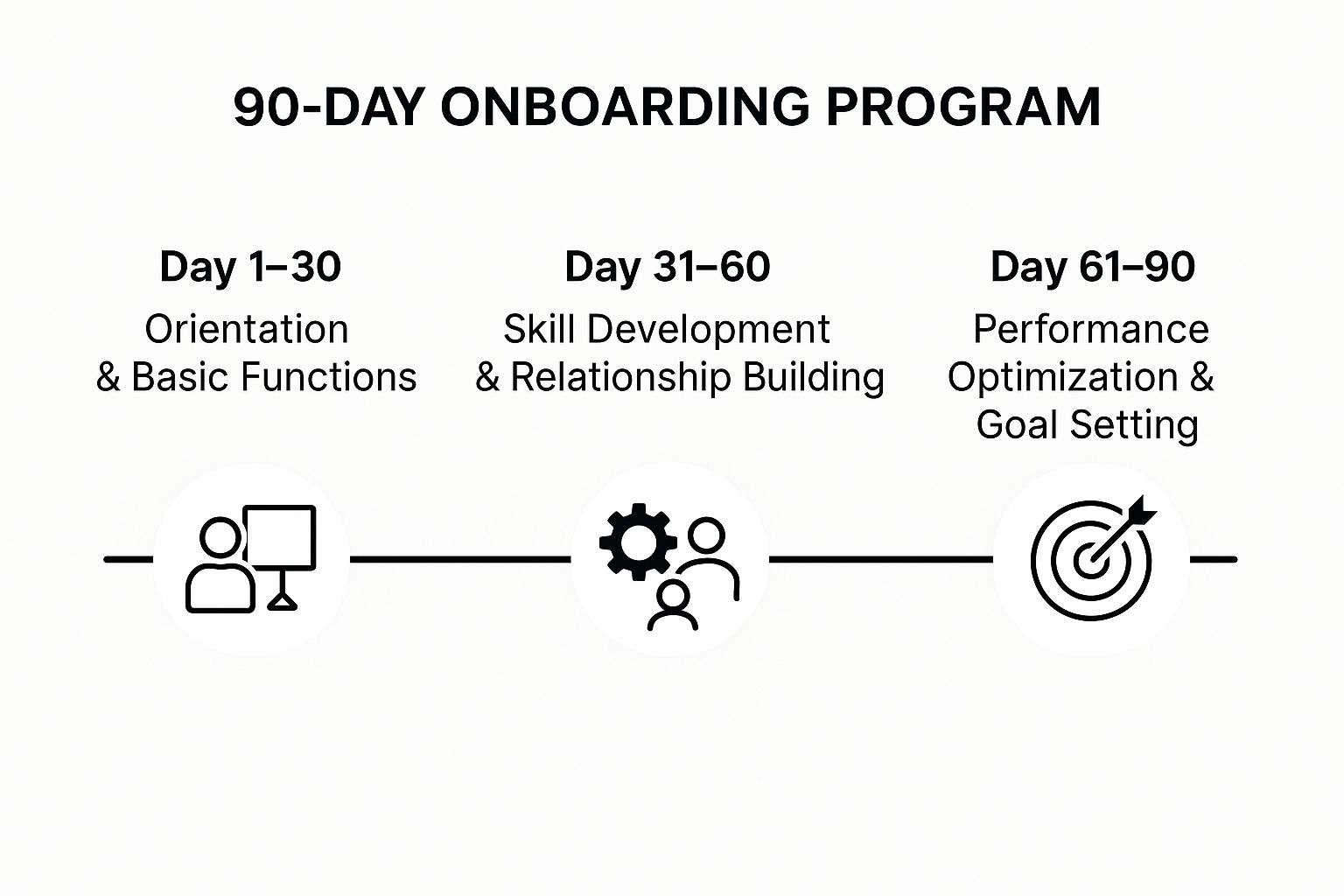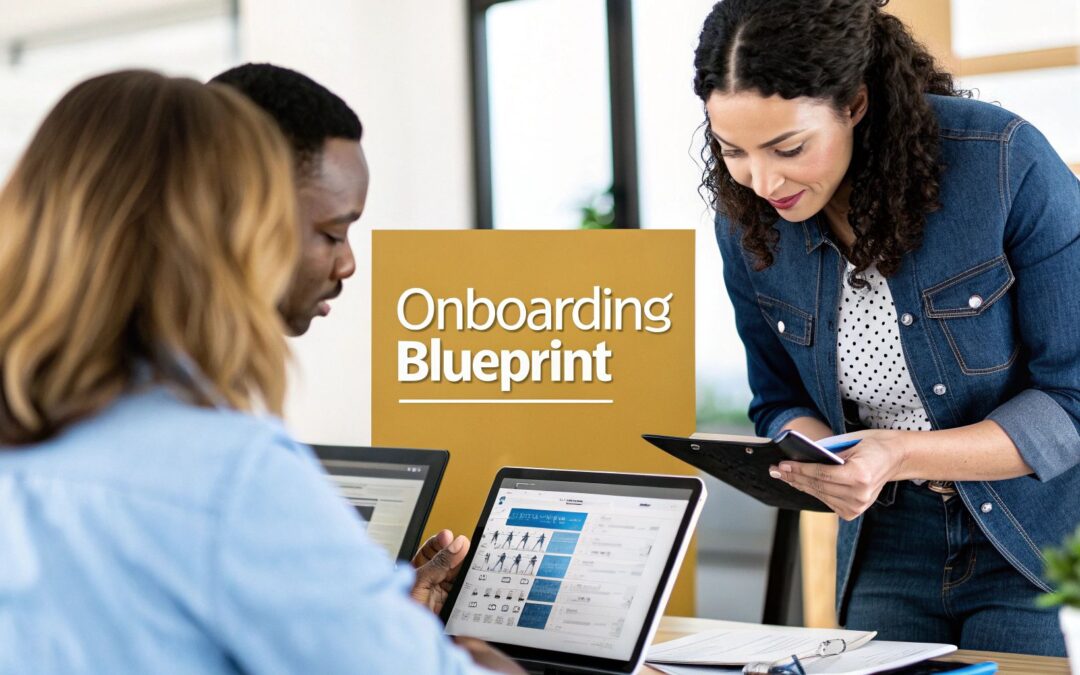In today's competitive talent market, a weak onboarding process is more than an inconvenience; it's a critical business risk leading to early turnover and lost productivity. Simply handing a new hire a laptop and a handbook is a relic of the past. The journey from a promising candidate to a fully integrated, high-performing team member requires a deliberate, strategic, and human-centric approach. This article moves beyond generic checklists to provide a detailed roundup of the most impactful employee onboarding best practices that top companies are using to build engaged, confident, and loyal teams from day one.
We will explore eight essential strategies, from the crucial pre-boarding phase to establishing robust feedback loops, providing actionable steps and real-world examples. For a comprehensive exploration of the foundational principles and the latest trends, delve into the top employee onboarding best practices for 2025. This guide focuses on specific, implementable tactics.
Additionally, we'll highlight how integrating specialized manpower and data services, like those offered by Zilo AI, can automate and enhance these practices. Our goal is to ensure a seamless, scalable, and data-driven onboarding experience that sets your new hires, and your organization, up for long-term success.
1. Pre-boarding Preparation
The journey to creating a successful employee experience begins long before their first day. Pre-boarding is the critical period between a candidate accepting a job offer and their official start date. This phase sets the tone for the entire employment relationship, making it a cornerstone of effective employee onboarding best practices. It's about transforming a candidate's initial excitement into genuine, lasting engagement by making them feel valued and prepared from the moment they say "yes."

A strong pre-boarding process reduces first-day anxiety and minimizes the risk of new-hire attrition. It confirms to the new employee that they made the right choice and demonstrates your organization's commitment and efficiency. For example, Zappos sends new hires a care package with company swag and personal welcome notes, while HubSpot creates personalized welcome videos from the team to build an immediate connection.
How to Implement Pre-boarding
To integrate this practice, focus on structured communication and logistical readiness. The goal is to handle all administrative hurdles and foster a sense of belonging before day one, allowing the new hire to focus on integration and learning when they arrive.
- Create a Pre-boarding Checklist: Develop a detailed timeline of tasks. This should include sending the welcome email within 24 hours of offer acceptance, initiating IT setup (laptops, accounts, software access), and preparing their physical or virtual workspace.
- Send a Welcome Kit: A physical or digital package can make a huge impact. Include company swag, a welcome letter from the CEO or team lead, essential first-week information, and materials that introduce company culture, like a values handbook.
- Facilitate Early Connections: Introduce the new hire to their direct team and a designated "onboarding buddy" via email or a brief virtual meet-and-greet. This simple step helps them feel like part of the team immediately.
- Manage Paperwork Digitally: Use an HRIS or digital signature platform to get all necessary contracts and forms completed in advance. This avoids a first day bogged down by tedious administrative tasks.
2. Structured 90-Day Onboarding Program
A successful onboarding experience extends far beyond the first week. A structured 90-day onboarding program is a comprehensive framework that guides new hires from initial orientation to full productivity. Popularized by Michael Watkins' book, "The First 90 Days," this approach is one of the most effective employee onboarding best practices because it breaks down the complex integration process into manageable, milestone-driven phases. It provides a clear roadmap for success, ensuring new employees build the right skills, relationships, and confidence to thrive long-term.
This infographic illustrates the phased structure of a typical 90-day onboarding journey.

The timeline demonstrates a progression from foundational learning to strategic contribution, giving both the employee and the manager a clear path to follow. For example, Microsoft implements a highly structured program with weekly goals and project milestones, while Salesforce uses its V2MOM framework (Vision, Values, Methods, Obstacles, Measures) to align new hires with company objectives throughout their first 90 days. This methodical approach ensures employees become valuable, contributing members of the team faster.
How to Implement a 90-Day Program
To build an effective 90-day plan, you must define clear objectives for each 30-day interval. This structure should be customized for different roles but maintain a consistent core framework that aligns with company-wide goals and cultural values.
- Set 30-60-90 Day Goals Collaboratively: Work with the new hire to define specific, measurable, achievable, relevant, and time-bound (SMART) goals for each phase. The first 30 days should focus on learning, the next 30 on contributing, and the final 30 on taking initiative.
- Schedule Regular Check-ins: Formal meetings at the 2-week, 30, 60, and 90-day marks are crucial. These conversations provide opportunities for feedback, course correction, and reinforcement, ensuring the new employee feels supported.
- Balance Hard Skills and Cultural Integration: The plan must include both technical training for the role and activities that immerse the new hire in the company culture. This includes introductions to key stakeholders outside their immediate team.
- Document and Iterate: Keep a record of the employee's progress against their goals. Use feedback from both the new hire and their manager to continuously refine and improve the 90-day onboarding program for future employees.
3. Buddy/Mentor Assignment System
A structured buddy or mentor system is one of the most impactful employee onboarding best practices for fostering a sense of belonging and accelerating integration. This practice involves pairing a new employee with an experienced colleague who serves as their go-to resource, guide, and cultural ambassador. More than just a friendly face, a buddy provides a safe space for new hires to ask informal questions they might be hesitant to bring to a manager, helping them navigate unwritten social rules and build crucial internal networks.

This dedicated support system humanizes the onboarding experience, significantly boosting confidence and reducing time-to-productivity. For instance, Southwest Airlines assigns "Culture Champions" who focus specifically on cultural immersion, while Accenture’s program provides specialized training to volunteer buddies. These programs show that a formal system is far more effective than hoping for organic connections to form on their own, ensuring every new hire receives consistent support.
How to Implement a Buddy/Mentor System
A successful program requires structure, clear expectations, and thoughtful pairing. The goal is to create a mutually beneficial relationship that supports the new hire while providing a leadership development opportunity for the mentor.
- Select and Train Mentors: Choose buddies based on their strong communication skills, deep understanding of company culture, and genuine enthusiasm for helping others, not just their job title or tenure. Provide them with a guide outlining their role, responsibilities, and conversation starters.
- Set Clear Expectations: Define the time commitment (e.g., weekly check-ins for the first month) and the scope of the relationship. Clarify that the buddy is a cultural and social guide, not responsible for job-specific performance management.
- Structure Initial Interactions: Don't leave it to chance. Schedule the first coffee or lunch meeting and provide a checklist of initial topics, such as a team introduction, a tour of communication tools, or explaining company traditions.
- Gather Feedback and Iterate: Regularly check in with both the new hire and the buddy to see how the relationship is progressing. Use this feedback to refine your matching process and support resources for future pairings.
4. Role-Specific Training and Job Shadowing
A successful onboarding program moves beyond general company orientation to provide deep, role-specific learning. This involves a blended approach that combines formal instruction with hands-on job shadowing. This dual strategy ensures new hires not only understand the theoretical aspects of their role but also see how those duties are performed in real-world scenarios, bridging the gap between knowledge and practical application. It is a cornerstone of effective employee onboarding best practices that accelerates proficiency and builds confidence.
Pairing structured training with direct observation helps new team members quickly grasp the nuances, workflows, and unspoken rules of their position. For instance, Amazon uses intensive hands-on training for its warehouse roles, where new associates learn by doing, while Goldman Sachs implements a rigorous shadowing program for new analysts on the trading floor to immerse them in a high-stakes environment. This practical immersion is critical for complex or high-pressure roles.
How to Implement Role-Specific Training and Job Shadowing
The key to this practice is creating a structured yet flexible plan that gives new hires a comprehensive view of their responsibilities. The goal is to build competence and integrate them into the team’s daily operational rhythm.
- Develop a Structured Shadowing Schedule: Don't leave job shadowing to chance. Create a detailed schedule that outlines who the new hire will shadow, for how long, and what specific learning objectives they should focus on during each session.
- Provide Shadowing Guides: Equip both the new hire and the experienced colleague with a guide. This document should include key processes to observe, suggested questions to ask, and specific tasks to review, ensuring the sessions are productive.
- Rotate Mentors and Experiences: Allow the new hire to shadow multiple team members. This exposes them to different working styles and provides a more rounded understanding of the role and its collaborations across the team.
- Combine Observation with Practice: Follow up shadowing sessions with opportunities for the new hire to perform the tasks themselves, first in a controlled environment and then in live situations. This active learning reinforces the observed skills.
5. Clear Goal Setting and Expectations Communication
A new employee's path to productivity is paved with clarity, not assumptions. One of the most impactful employee onboarding best practices is the systematic establishment of clear goals and expectations from the outset. This practice moves beyond a simple job description, providing a structured framework that defines what success looks like in the first 30, 60, and 90 days. It eliminates ambiguity and empowers new hires to direct their energy toward meaningful contributions that align with team and company objectives.
When new hires understand their role's specific impact and how their performance will be measured, they feel more confident and integrated. For example, Intel famously uses the OKR (Objectives and Key Results) system, popularized by Andy Grove, to align new hire goals with company-wide priorities. Similarly, Adobe’s Check-In process involves regular conversations about performance and expectations, ensuring goals remain relevant and achievable. This structured approach accelerates the learning curve and fosters a culture of accountability and achievement.
How to Implement Clear Goal Setting
Integrating this practice involves creating a transparent, collaborative, and documented goal-setting process. The aim is to build a roadmap that guides the employee's initial months, making their contributions visible and their development intentional.
- Establish a 30-60-90 Day Plan: Develop a structured plan outlining specific, measurable, achievable, relevant, and time-bound (SMART) goals for the first three months. This should cover learning objectives, performance tasks, and relationship-building milestones.
- Set Goals Collaboratively: While managers should provide a framework, the most effective goals are set with input from the new hire. This collaborative approach increases buy-in and ensures the goals are realistic and motivating.
- Connect Individual Goals to Broader Objectives: Clearly illustrate how the new employee's responsibilities and initial projects contribute to the team's and the organization's strategic priorities. This provides a powerful sense of purpose.
- Schedule Regular Check-ins: Plan weekly or bi-weekly meetings specifically to discuss progress against goals. These sessions are crucial for providing feedback, adjusting priorities, and offering support, preventing new hires from feeling lost or overwhelmed.
6. Cultural Integration and Company Values Immersion
True onboarding excellence goes beyond processes and paperwork; it involves immersing new employees into the very heart of the organization: its culture and values. This practice focuses on creating a genuine emotional connection by sharing the company's story, purpose, and unwritten social norms. It transforms new hires from outsiders into passionate brand advocates who understand not just what they do, but why they do it.

Effective cultural integration ensures new hires feel a sense of belonging and make decisions that align with the company’s core principles. For example, Zappos famously hosts a "Culture Camp" where new team members engage in games and activities directly tied to their 10 core values. Similarly, Patagonia integrates its environmental mission through outdoor activities and sustainability workshops, making its purpose tangible from day one. A cornerstone of successful onboarding involves deeply integrating new hires into the company’s unique environment. Understanding strategies for how to improve company culture is essential for creating this immersive experience.
How to Implement Cultural Integration
To effectively weave culture into your onboarding, shift from passive presentations to active, experiential learning. The objective is to make your company's values a living, breathing part of the new hire's daily work life, not just a poster on the wall.
- Share Authentic Stories: Go beyond generic mission statements. Dedicate time for founders, leaders, and long-tenured employees to share real stories about company history, pivotal moments, and how values guided decisions during challenges.
- Create Interactive Experiences: Design activities that reflect your culture. If collaboration is a key value, organize a team-based problem-solving challenge. If it's innovation, host a mini-hackathon or brainstorming session.
- Connect Values to Daily Work: Show, don't just tell. Use real-world scenarios to demonstrate how company values translate into everyday tasks, customer interactions, and team communication.
- Include Diverse Voices: Ensure the stories and perspectives shared represent the full spectrum of your workforce. This reinforces inclusivity as a core part of the culture and helps new hires from all backgrounds see themselves in the company's narrative.
7. Regular Check-ins and Feedback Loops
Onboarding doesn't end after the first week. To ensure a new hire's long-term success, organizations must implement a systematic approach for consistent communication. This practice involves scheduled check-ins, formal feedback sessions, and ongoing progress reviews. It creates a continuous dialogue that helps identify challenges early, celebrate wins, and provide unwavering support, making it one of the most vital employee onboarding best practices. This structured communication transforms onboarding from a one-time event into an integrated, supportive journey.
A robust feedback loop demonstrates that you are invested in the employee's growth and well-being beyond their initial training. It fosters psychological safety, encouraging new hires to voice concerns before they become significant issues. For example, Facebook's managers conduct weekly check-ins using structured conversation guides to cover progress and roadblocks. Similarly, Spotify uses a peer feedback system to provide well-rounded insights, and Slack automates simple "How's it going?" surveys to prompt manager follow-ups, ensuring no one slips through the cracks.
How to Implement Check-ins and Feedback
The key to successful implementation is consistency and creating a safe space for honest dialogue. The focus should be on support and development, not just performance evaluation. This helps new employees feel seen, heard, and valued as they navigate their new role and responsibilities.
- Schedule a Cadence: Establish a clear schedule for check-ins, such as weekly for the first month, bi-weekly for the next two months, and monthly thereafter. Put these meetings on the calendar in advance to signal their importance.
- Use a Structured Framework: Equip managers with a guide of structured questions to ensure consistency but also allow for open-ended conversation. Questions can cover role clarity, resource availability, team dynamics, and personal well-being.
- Train Your Managers: Don't assume managers instinctively know how to conduct effective feedback sessions. Provide training on active listening, coaching techniques, and how to deliver constructive feedback that empowers rather than discourages.
- Document and Follow Up: Keep a record of discussion points, goals, and action items from each check-in. This creates accountability and shows the new hire that their feedback is being taken seriously and acted upon.
8. Technology Integration and Digital Tools Setup
In today's digital-first workplace, a new hire's ability to contribute effectively is directly tied to their proficiency with technology. Technology integration and digital tools setup involves the comprehensive preparation and training on all systems, software, and platforms the employee will use. This practice is a critical component of employee onboarding best practices, ensuring a seamless transition into the company's digital workflows and minimizing productivity-draining technical frustrations.
A well-executed tech onboarding process empowers employees from day one, giving them the confidence and access needed to perform their duties. For instance, Apple provides new hires with fully configured devices loaded with personalized, role-specific software, while Atlassian offers a self-service portal with integrated training modules for its suite of tools. This proactive approach prevents a common onboarding pitfall: a new employee unable to work because they lack the necessary logins or tool knowledge.
How to Implement Technology Integration
Effective implementation goes beyond just creating accounts. It requires a structured, supportive approach that combines preparation, training, and ongoing support to ensure new hires are not just equipped but also confident in using their digital toolset. To truly leverage technology, consider solutions like automating employee onboarding processes to streamline digital tool setup and access.
- Prepare All Access Before Day One: Work with IT to ensure all hardware is configured and all accounts, from email to project management software, are created and tested before the new hire arrives.
- Create Step-by-Step Guides: Develop clear, accessible documentation or short video tutorials for essential tools and common processes. Store these in a centralized, easy-to-find knowledge base.
- Provide Hands-On, Role-Specific Training: Schedule dedicated sessions for hands-on practice with the most critical software. Tailor the training to the employee's specific role rather than providing generic overviews.
- Assign a Tech Mentor or Point of Contact: Designate a go-to person on the team who can answer quick technical questions, preventing small issues from becoming major roadblocks.
- Regularly Update Training Materials: Technology evolves quickly. Review and update all training guides and materials quarterly to reflect any software updates or process changes.
8 Key Employee Onboarding Practices Comparison
| Onboarding Item | Implementation Complexity 🔄 | Resource Requirements ⚡ | Expected Outcomes 📊 | Ideal Use Cases 💡 | Key Advantages ⭐ |
|---|---|---|---|---|---|
| Pre-boarding Preparation | Medium 🔄🔄 | Moderate ⚡⚡ | Higher engagement, reduced first-day anxiety 📊📊 | Organizations wanting to engage hires early and reduce admin delays | Increases excitement, reduces risk of offer withdrawal ⭐⭐ |
| Structured 90-Day Onboarding Program | High 🔄🔄🔄 | High ⚡⚡⚡ | Faster productivity ramp-up, better retention 📊📊📊 | Companies aiming for consistent, phased integration over months | Clear roadmap, measurable progress, consistent experience ⭐⭐⭐ |
| Buddy/Mentor Assignment System | Medium 🔄🔄 | Moderate ⚡⚡ | Faster cultural integration, support system 📊📊 | Organizations emphasizing cultural fit and peer support | Reduces isolation, builds relationships, develops leadership ⭐⭐ |
| Role-Specific Training and Job Shadowing | High 🔄🔄🔄 | High ⚡⚡⚡ | Skills readiness, improved job performance 📊📊 | Roles requiring hands-on skills and practical learning | Direct role relevance, confidence building, early skill gap ID ⭐⭐ |
| Clear Goal Setting and Expectations Communication | Medium 🔄🔄 | Moderate ⚡⚡ | Clarity, motivation, objective measurement 📊📊 | Fast-paced or performance-driven environments | Reduces ambiguity, supports feedback, career planning ⭐⭐ |
| Cultural Integration and Company Values Immersion | Medium 🔄🔄 | Moderate ⚡⚡ | Strong emotional connection, better retention 📊📊 | Companies focused on culture alignment and long-term engagement | Builds belonging, reduces culture shock, increases engagement ⭐⭐ |
| Regular Check-ins and Feedback Loops | Medium 🔄🔄 | Moderate ⚡⚡ | Early issue detection, strong relationships 📊📊 | Organizations valuing continuous communication and support | Supports feedback, reduces turnover, builds trust ⭐⭐ |
| Technology Integration and Digital Tools Setup | High 🔄🔄🔄 | High ⚡⚡⚡ | Faster productivity, technical readiness 📊📊 | Roles heavily dependent on technical tools and systems | Minimizes frustration, ensures security, enables quick contribution ⭐⭐ |
Transforming Onboarding from a Process into a Competitive Advantage
Moving beyond a simple checklist, the journey of integrating a new team member is one of the most strategic investments a company can make. The employee onboarding best practices detailed throughout this article, from meticulous pre-boarding to establishing robust feedback loops, are not isolated tasks. Instead, they are interconnected components of a comprehensive strategy designed to build a foundation for long-term success, both for the employee and the organization. A haphazard approach leads to disengagement and early turnover, but a deliberate, well-executed program fosters loyalty, accelerates productivity, and reinforces a positive company culture.
Key Takeaways for a World-Class Onboarding Experience
Recapping the essential pillars, a successful onboarding framework is built on foresight and structure. It begins before day one with thoughtful pre-boarding and extends through a structured 90-day plan that provides clarity and direction. The human element, facilitated through a buddy system and regular, meaningful check-ins, is what transforms the process from a procedural formality into a genuinely welcoming experience.
Furthermore, equipping new hires for success requires a dual focus:
- Role-Specific Mastery: Providing targeted training, job shadowing, and clear performance goals ensures employees understand exactly how to contribute and what success looks like in their position.
- Cultural Immersion: Actively integrating newcomers into the company’s values and social fabric helps them feel a true sense of belonging, which is a powerful driver of engagement.
From Good Practice to Great Performance
The true value of mastering these employee onboarding best practices lies in their cumulative impact. When executed consistently, they create a powerful cycle. Well-onboarded employees become productive faster, feel more connected to your mission, and are significantly more likely to remain with your company, reducing costly turnover. This enhanced retention allows you to build a more experienced, cohesive, and innovative team.
However, building and managing such a comprehensive program demands significant administrative effort, coordination, and resources. For many organizations, especially those scaling quickly or operating in specialized fields like AI, managing these operational details can distract from core business objectives. This is where a strategic partnership can be a game-changer. Leveraging expert manpower and data services can help you execute these best practices flawlessly and at scale. For instance, creating high-quality, annotated training datasets for new AI engineers or sourcing skilled personnel to manage the onboarding program itself are specialized tasks that can be streamlined effectively. Ultimately, investing in a superior onboarding experience is a direct investment in your talent pipeline and your company's competitive edge.
Ready to elevate your onboarding program from a simple checklist to a strategic asset? Discover how Zilo AI can provide the expert manpower to run your programs and the specialized data services to create world-class training materials for your teams. Visit Zilo AI to learn how we empower companies to build, train, and retain top talent.

